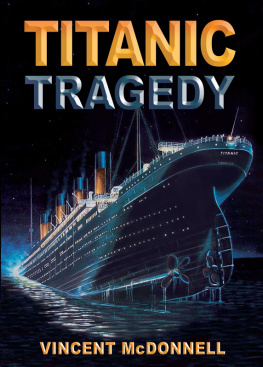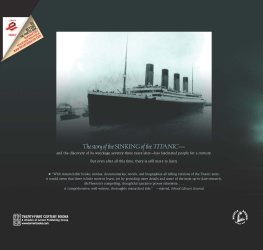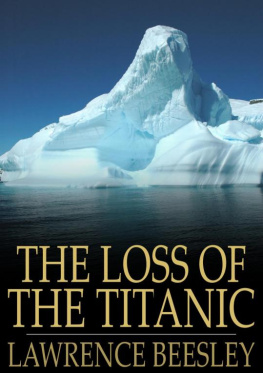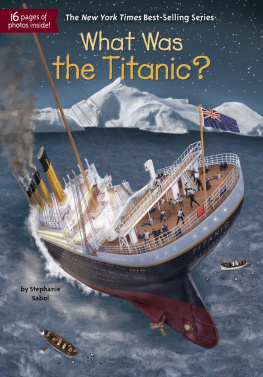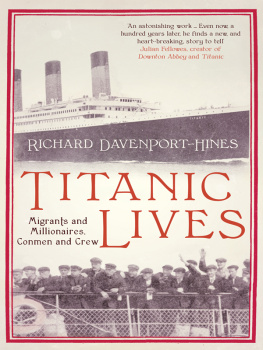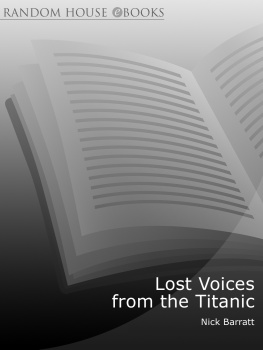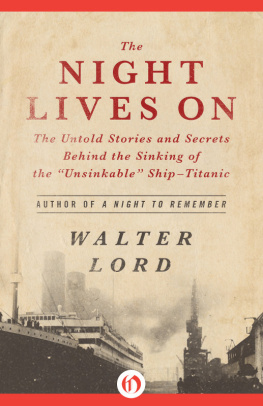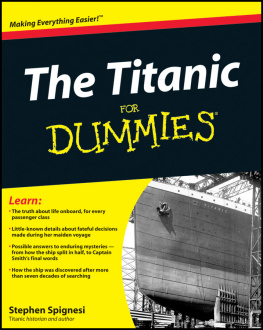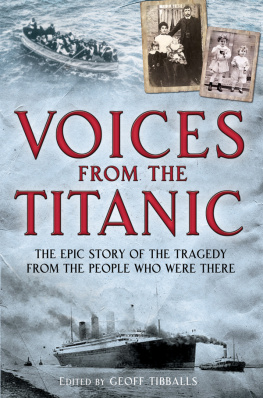DOWN IN THE DEEP

F our thousand metres beneath the Atlantic Ocean lies the wreck of a great ship. It is a dark, silent world down there. Its only inhabitants are fish and creatures of the deep. Almost 100 years has passed since the ship sank. In that time, only a handful of people have ever descended to the wreck and seen its watery grave.
Yet the rusting remains hold an enduring interest that has not lessened since it sank on a cold, April night in 1912. For, despite the thousands of ships which have sunk since man first sailed the oceans of the world, this one lying deep beneath the Atlantic is the most famous of all of them.
It still holds a special mystery and fascination, which shows no sign of fading. In fact, its fame has increased through the years. Today, people still speak of it with awe. Many books have been written about it, as have songs and poems, and Hollywood has made films about it.
Yet it was a young ship when it sank. It was on its first, or maiden, voyage across the Atlantic. It was sailing to New York from Cobh, County Cork, then known as Queenstown.
The ship sank on a calm, cold, starry night. Its fate was decided in less than 60 seconds. One moment it was sailing majestically through the darkness, with all its light ablaze. Then an iceberg was sighted dead ahead.
A warning bell peeled in the darkness. The ship's wheel was spun hard-a-starboard. But it was too late. The ship's hull collided with an underwater section of the iceberg. Minutes later, its lights still ablaze, the stricken ship lay motionless in the water. Its fate was sealed and it was doomed to die.
Already the dark waters of the Atlantic Ocean were gushing in through a gash torn in its side by the collision. In less than three hours the largest ship ever built would break in two. Its bow and stern would then sink slowly beneath the waves.
The ship, built in Belfast and described as unsinkable, was to become a grave for the 1,503 men, women and children who drowned in the tragedy. Of the 2,208 passengers and crew on board that April night, only 705 survived to tell the story of what happened.
It is a story of foolishness and rash stupidity. It is a story of man's greed, pride and ambition. It is also a story of heroism, bravery and sacrifice, and of terrible cowardice. It is a story of chance and of the many lives and dreams that were destroyed, and a story of the families who were separated by the tragedy.
Some of the men and women who survived were hailed as heroes. Many of those who perished did so heroically. But many men behaved in a shameful, cowardly manner that night. They lived out their lives in disgrace, aware that in saving themselves they had left others to their fate. Many of those left to drown were women and children.
The ocean, however, is an indifferent entity. It does not care who lives or dies, whether they are young or old, male or female, rich or poor. It will accept them all and take them to a watery grave.
Many of their names are still remembered today. The names Bruce Ismay, Sir Cosmo and Lady Duff-Gordon, Robert Hitchens and Major Peuchen, have become associated with cowardice.
Others, like Thomas Andrews, Benjamin Guggenheim, Colonel Archibald Gracie, Ida Straus, Molly Brown and twelve-year-old Ruth Becker are remembered for their bravery and courage that night.
This is the story of that fateful night. This is the story of those men, women and children who lived and those who died. This is a story of heroism, cowardice and great sacrifice.
It is also the story of one of the finest and most famous ships ever to sail the seas, why she was built and the men who built her. The story also tells how she now lies silent and rusting beneath the Atlantic waves.
Her name is Titanic and this is her story.
THE NEW WORLD

F rom the beginning of time man has been fascinated by the sea. He has stood on the shores of the world's oceans and watched the ceaseless movement of the water. He has gazed out towards the horizon and wondered what lay beyond that line where the sky joined the sea.
Curiosity has been part of the driving force of humankind. It was this curiosity that made men determined to discover what lay on the other side of the great oceans. Driven by their desire to know, men took to the oceans in boats and travelled beyond the horizon.
These first boats were built of wood and propelled by paddles. Later sails were added which harnessed the power of the wind. In places where wood was scarce, rafts were built from bundles of reeds lashed together. Boats were also constructed from wooden frames covered with animal hides and sealed with pitch.
In these flimsy craft, men traversed the oceans. Around the middle of the sixth century, Saint Brendan, the Navigator, sailed from Ireland to many of the islands off the Scottish coast. Legend has it that he sailed to America in his flimsy leather boat 800 years before Christopher Columbus.
Leif Ericsson, the great Norse explorer, is also credited with having reached America around 1,000AD. The remains of what are thought to be a Viking settlement were discovered in Newfoundland in 1963. But there is no absolute evidence that Saint Brendan or Leif Ericsson ever reached America.
What is fact is that Christopher Columbus reached what we now know as the West Indies in 1492. He had been seeking a new route to India but instead discovered what was to become known as the New World.
It was this discovery that was to lead to the building of Titanic, more than 400 years later. Like Columbus own ship, the Santa Maria, the Titanic was destined to become one of the most famous ships ever to sail the seas.
Following in the footsteps of Columbus, others sailed to this New World from Spain, Portugal and England. It was from one of these men, Amerigo Vespucci, allegedly the first European to set foot on the mainland, that this New World got the name America.
These adventurers brought back stories of a vast land. It was a land where a man could become rich beyond his wildest dreams. These dreams in turn fired the imagination of many other adventurers and they too travelled to America seeking their fortunes.
The vast Atlantic Ocean lay between Europe and the new land of America. The only means of travelling there was by ship. These ships were built of wood and had sails to harness the power of the wind. They were small and cramped, and extremely uncomfortable. Dependent as they were on the wind, they could take months to complete a crossing.
Passengers and crew suffered greatly on these voyages. The Atlantic was a wild, vast ocean. Storms often raged there. Many ships were lost and all on board drowned. Yet despite this, people from all over Europe and Asia were willing to take the risk in order to begin a new life in this exciting new country.
They travelled for numerous reasons. Many were escaping poverty, others were escaping religious persecution. Many were fleeing from wars which seemed to be forever raging in Europe. Whatever the reason, all were hoping for a new, more certain and prosperous life in America.
By the nineteenth century America was a vastly different country to what it had been at the time of Columbus. Cities like New York and Boston were being built. Men had travelled across the vast country from the east to the west coast. Gold had been discovered in California, which led to the famous gold rush of 1849.
In the south, huge plantations grew cotton and tobacco. Slaves, brought on ships across the Atlantic from Africa, supplied the labour. On the vast prairies men had begun to raise cattle and grow grain crops like wheat to feed the population.
Next page
